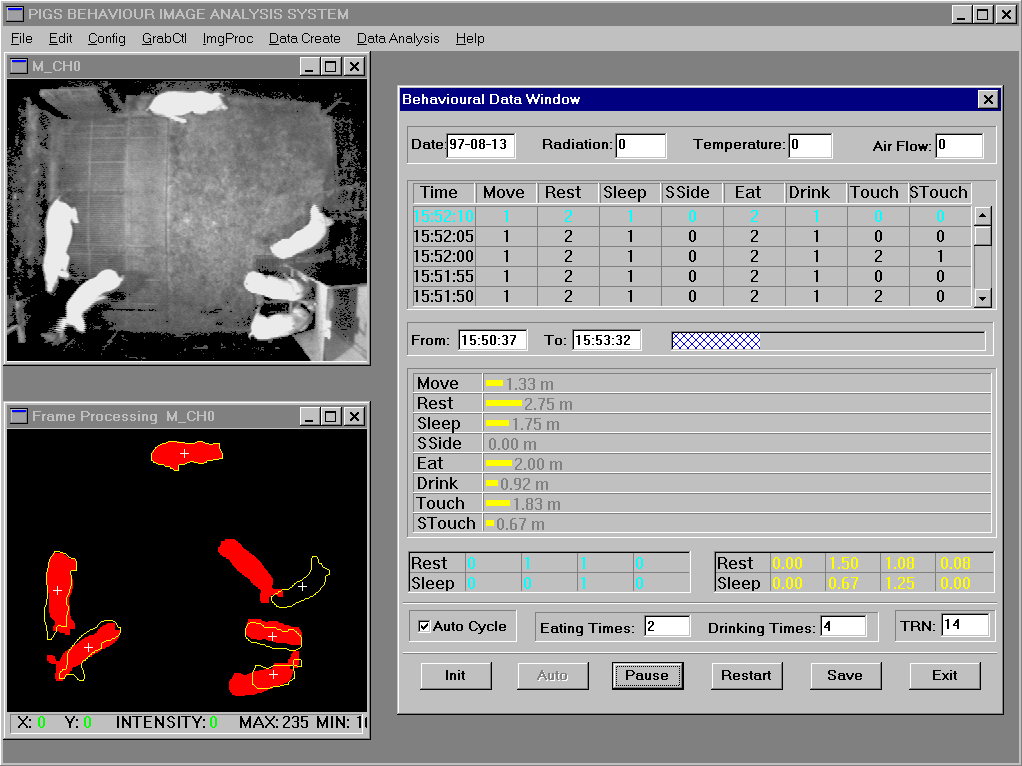
Automatic analysis of the behaviour of group-housed pigs by an image collection system
L.Tang1, F. Mulkens2, S. Godrie2, L. Freson2, R. Zheng3 and R. Geers2
1 Department of Agricultural Engineering, University of
Illinois at Urbana-Champaign, Urbana, IL, U.S.A.
2 Laboratory for Agricultural Buildings Research, Katholieke Universiteit
Leuven, Leuven, Belgium
3 Laboratory of Building Physics, Katholieke Universiteit Leuven, Leuven,
Belgium
It is often difficult to obtain behavioural data of animals by means of a machine vision system, because animals are not rigid, and interactions occur when group-housed. Since the paper-and-pencil method is hardly feasible and apt to misrecording, the value of an auto-recording system for group-housed animals is obvious [1]. We developed a conventional machine vision system to automatically extract meaningful behavioural data of group-housed pigs (3-4 pigs within a pen of 5 m˛) from sequential images. A monochrome CCD camera with centre top view of the pen was connected to an image analysis system, which consisted of a PC, a Matrox Meteor frame grabber and a Matrox MGA graphic accelerator VGA card. User-friendly software, using an interface on a Windows platform, was developed by programming with Borland C++ 4.5 (Fig. 1). Main techniques adopted were image processing, logic reasoning and time-sequence-frame analysing. The behavioural categories were based on spatial and temporal information of the group activity. They covered the main behavioural patterns of group-housed pigs, like eating, sleeping, drinking, moving, and touching. Some sub-categories were also defined, like sleeping on side, and sleeping while touching. The accumulated time and frequency of each (sub)category can be calculated by the system for the whole observation period or at every grabbing interval. The observations can be videotaped and used by the system while the observer can make corrections. The processing of each frame takes 3 to 4 seconds, and the auto-recycling function makes the system capable to run for a sufficient long time. However, more pigs within the same observing area made the spatial-temporal analysis prone to mistakes since interactions between pigs were complex.

We can conclude that automatic data collection of group-housed pigs using top view images is feasible for applied ethology research. The present system was validated in an experiment on the influence of radiation on pigs [2]. By adjusting the algorithms according to the species-specific behavioural patterns, this system can also analyse the behaviour of other group-housed animals, like calves. But, for the behavioural analysis of fast moving group-housed animals, like rats, the processing speed is essential. A good quality image with high contrast is a must for reducing the image pre-processing time and ensuring good image segmentation. One efficient way to obtain high contrast image is to apply pre-filtering according to spectral reflectance of the animal. Using colour image will make it possible to distinguish individuals by using colour marks and can greatly improve the data accuracy, but the quantity of signals and the cost of the system will be increased.
L. Tang and R. Zheng are financially supported by Flemish Educational Ministry; F. Mulkens and S. Godrie by the IWT (Flanders). R. Geers is a research director of the FWO (Flanders).

Poster presented at Measuring Behavior '98, 2nd International Conference on Methods and Techniques in Behavioral Research, 18-21 August 1998, Groningen, The Netherlands